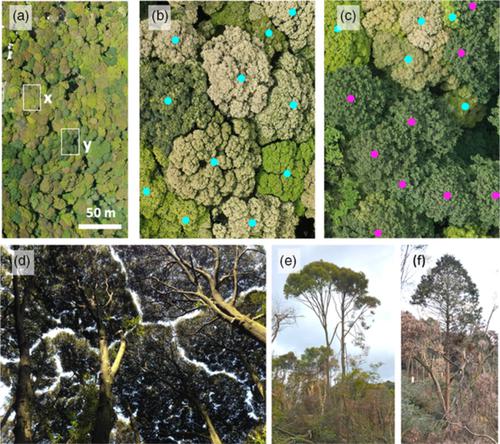当前位置:
X-MOL 学术
›
Ecol. Res.
›
论文详情
Our official English website, www.x-mol.net, welcomes your
feedback! (Note: you will need to create a separate account there.)
Wider crown shyness between broad-leaved tree species than between coniferous tree species in a mixed forest of Castanopsis cuspidata and Chamaecyparis obtusa
Ecological Research ( IF 1.7 ) Pub Date : 2021-05-21 , DOI: 10.1111/1440-1703.12233 Yusuke Onoda 1 , Reo Bando 1
Ecological Research ( IF 1.7 ) Pub Date : 2021-05-21 , DOI: 10.1111/1440-1703.12233 Yusuke Onoda 1 , Reo Bando 1
Affiliation

|
Persistent openings (gaps) between adjacent crowns at similar heights can be found in tall forests. Such openings are called “crown shyness” and are formed through the collision of tree crowns during high winds. While crown shyness has been studied in plantations, much less studied in natural forests despite its importance for light acquisition, competition, and coexistence. In this study, we focused on a mixed forest in Japan, and examined a hypothesis that broad-leaved tree species, which often have top-wide crowns, have wider crown shyness than coniferous tree species, which often have narrow cone-shape crowns, because top-wide crowns may be more exposed to wind and more likely to collide with their neighbors. Crown shyness, which was measured by drone imagery, was clearly found between individuals of the broad-leaved tree species Castanopsis cuspidata but not between the coniferous tree species Chamaecyparis obtusa. This interspecific difference may be associated with differences in crown shape; Castanopsis had wider (1.57-fold) and shallower (0.64-fold) crowns than Chamaecyparis. Within Castanopsis, the size of crown shyness tended to negatively correlated with stem diameter and positively correlated with stem slenderness. Our study showed that the difference in crown shape among species is one of the key factors in determining the size of crown shyness. Top-wide crowns of broad-leaved trees compared to conifers may have a competitive advantage in light interception, but it may come at the cost of crown collisions with adjacent crowns and resulting in persistent openings at the canopy layer.
中文翻译:

阔叶树种间比针叶树种间更宽的树冠羞涩性在栲栲和扁柏混交林中
在高大的森林中可以找到相似高度的相邻树冠之间的持久开口(间隙)。这种开口被称为“树冠羞涩”,是在大风期间通过树冠碰撞而形成的。虽然树冠害羞在人工林中得到了研究,但在天然林中的研究却很少,尽管它对采光、竞争和共存很重要。在这项研究中,我们专注于日本的混交林,并检验了一个假设,即通常具有顶部宽的树冠的阔叶树种比通常具有狭窄的锥形树冠的针叶树种具有更宽的树冠羞涩性,因为顶部宽的牙冠可能更容易暴露在风中,更容易与邻居发生碰撞。通过无人机图像测量的树冠羞怯在阔叶树种的个体之间被清楚地发现Castanopsis cuspidata但不在针叶树种Chamaecyparis obtusa 之间。这种种间差异可能与冠部形状的差异有关;栲具有比Chamaecyparis更宽(1.57 倍)和更浅(0.64 倍)的冠。在栲,冠羞涩的大小与茎粗度呈负相关,与茎细长呈正相关。我们的研究表明,物种之间冠部形状的差异是决定冠部羞涩程度的关键因素之一。与针叶树相比,阔叶树的顶宽树冠在遮光方面可能具有竞争优势,但代价可能是树冠与相邻树冠碰撞并导致冠层持续开口。
更新日期:2021-07-02
中文翻译:

阔叶树种间比针叶树种间更宽的树冠羞涩性在栲栲和扁柏混交林中
在高大的森林中可以找到相似高度的相邻树冠之间的持久开口(间隙)。这种开口被称为“树冠羞涩”,是在大风期间通过树冠碰撞而形成的。虽然树冠害羞在人工林中得到了研究,但在天然林中的研究却很少,尽管它对采光、竞争和共存很重要。在这项研究中,我们专注于日本的混交林,并检验了一个假设,即通常具有顶部宽的树冠的阔叶树种比通常具有狭窄的锥形树冠的针叶树种具有更宽的树冠羞涩性,因为顶部宽的牙冠可能更容易暴露在风中,更容易与邻居发生碰撞。通过无人机图像测量的树冠羞怯在阔叶树种的个体之间被清楚地发现Castanopsis cuspidata但不在针叶树种Chamaecyparis obtusa 之间。这种种间差异可能与冠部形状的差异有关;栲具有比Chamaecyparis更宽(1.57 倍)和更浅(0.64 倍)的冠。在栲,冠羞涩的大小与茎粗度呈负相关,与茎细长呈正相关。我们的研究表明,物种之间冠部形状的差异是决定冠部羞涩程度的关键因素之一。与针叶树相比,阔叶树的顶宽树冠在遮光方面可能具有竞争优势,但代价可能是树冠与相邻树冠碰撞并导致冠层持续开口。











































 京公网安备 11010802027423号
京公网安备 11010802027423号